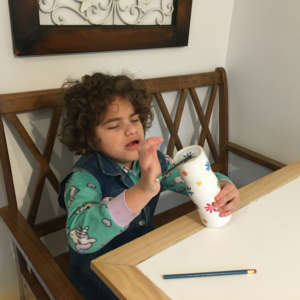Why I Can’t Wait to Change My Angel’s AAC App
It's time to switch to a new augmentative and alternative communication device
Written by |

I’ve had a big lightbulb moment about my 12-year-old Angel’s communication device.
Juliana had a breakthrough last week when she used a sight word to request a visit to Chick-fil-A. The scenario confirmed what I’d been thinking for a while: It’s time to level up Juliana’s vocabulary, which means changing the software on her Talker. (Juliana’s Talker is really an iPad with an app that turns the device into an augmentative and alternative communication (AAC) device.)
Currently, I’m seeing a big uptick in her use of sight words. But I’m also seeing a deficit. Once Juliana clearly indicates that she wants to “go” or “stop” an action, she also needs choices behind the request. For example, stop what? Go where? Years ago, her therapist asked me if Juliana had a way to identify preferences beyond her favorites on her iPad. The answer is no, but I need to turn that into a yes.
Ready for more
I don’t want to have a pile of picture cards as options. What would happen if I don’t have a picture of what she wants next? Confusion, disappointment, and probably Juliana’s default: screaming. I realized that it was time to make a change. I need to upgrade Juliana’s options.
While recently reading an Angelman Syndrome News column by Mary Kay titled “The AAC Learning Curve,” I found myself going down a rabbit hole. In the column, Mary writes about learning to effectively use her daughter’s AAC. She praised the app that she chose.
One link in the column led to another, and before I knew it, I was sold on Speak for Yourself. Our current app uses PECS, for Picture Exchange Communication System, to identify single requests. Speak for Yourself builds vocabulary one word at a time. This will give Juliana better options for communication.
I think there’s something quirky about the timing of things. I had read this column before, but when I looked at the app a few years ago, I had concluded that it wouldn’t be right for Juliana.
Let’s go
I had originally thought the Speak for Yourself screen would be overwhelming for Juliana to navigate. Mary thought this, too, so she worked on honing her daughter’s fine motor skills to focus on single-word selection.
There’s no need to reinvent the wheel here. I’ll use the method Mary chose: inserting coins into a gumball machine. In addition to this, I’ll step up our other fine motor skills practice. Juliana has been using the skill box Pencil Pusher for years. I made the cylinder-shaped exerciser from a recycled snack container. It’s great practice for isolating and controlling certain fingers.

Juliana practices her fine motor skills by picking up pencils and pushing them into a small hole. (Photo by Sabrina L. Johnson)
I’ve had a big aha moment, and I can’t wait to test my theory about Juliana’s thirst for words. I’ve decided to wait until the Christmas holiday, when there will be more time to make the change. I know there’ll be a learning curve, but I feel we’re both ready for the move.
Mary said that when people ask about the best app for their child, she responds, “The one they will use.” I think she’s on to something. While it might be a little tricky at first, I’m giddy at the thought of Juliana having places to choose when she decides she wants to “go.”
Note: Angelman Syndrome News is strictly a news and information website about the disease. It does not provide medical advice, diagnosis, or treatment. This content is not intended to be a substitute for professional medical advice, diagnosis, or treatment. Always seek the advice of your physician or other qualified health provider with any questions you may have regarding a medical condition. Never disregard professional medical advice or delay in seeking it because of something you have read on this website. The opinions expressed in this column are not those of Angelman Syndrome News or its parent company, Bionews, and are intended to spark discussion about issues pertaining to Angelman syndrome.







Leave a comment
Fill in the required fields to post. Your email address will not be published.